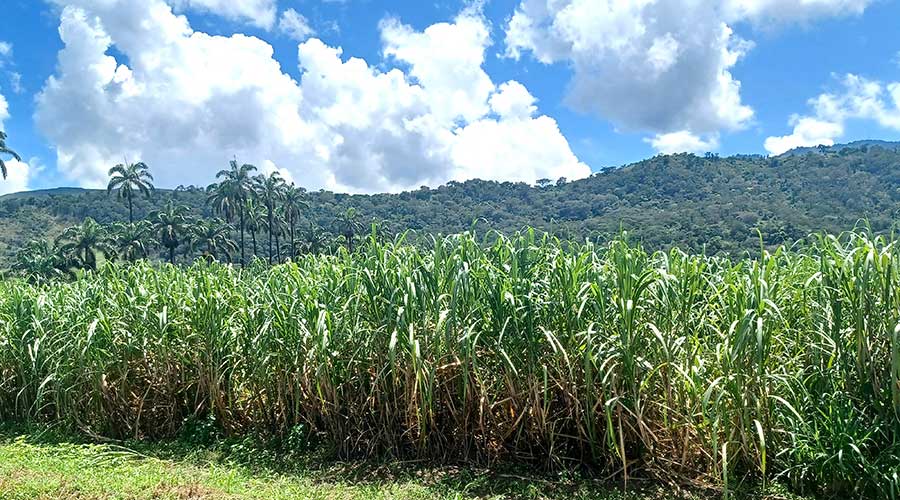Our contributor Matthieu Lange was lucky enough to visit the mountainous Aragua valley. Follow the guide!
Spirit tourism has been developing rapidly in our overseas territories for several years now. But it’s a global phenomenon. From Australia to Brazil, via Barbados, our sugar and rum heritage, some of which is still very much alive, is being maintained and restored to welcome the public.
Today, it’s at Santa Teresa’s Hacienda in Venezuela that we’re setting down our luggage. The site has been open to the public since 1988, demonstrating the long-standing interest of the country’s leaders in the subject.
A visit to the Hacienda
The Hacienda is made up of different areas, the heart of which is the Aragua Cruz, the Aragua Cross. This cross is actually the junction of the estate’s two main roads, lined with magnificent palm trees over 20 metres high. In the middle of the immense estate stand the distillation columns, to which visitors are led.
From the relatively distant view of these columns, visitors can see the rum-making process painted on a large wall. But whereas in our overseas territories the distillation apparatus is proudly displayed to the public, at the Hacienda visitors do not walk at the foot of the columns. This is mainly for safety reasons.
The columns are also considered, quite rightly, to be highly, if not overly, technical, and would require a special presentation. In the cellars, however, visitors can marvel at the sheer mass of casks before their eyes.
The shades of wood enrich the visual impact of the space. Barrels of different ages are unveiled by cellar masters Nestor Ortega and Nancy Duarte. Visitors are taken to the static aging cellars and then to the solera aging cellars. The organisers then take visitors to the bottling plant.
The tasting, organised at the end of the visit, takes place in the Bodega de Santa Teresa, which has been converted into a conference centre for up to 500 people. A tasting room and private winery have been installed there.
The Hacienda’s heritage
The former El Consejo railway station, located in the Hacienda, has been completely restored. It was one of the stops on the Gran Ferrocarril de Venezuela, the Great Venezuelan Railway, which ran between Caracas and Valencia from 1883 to 1966. The ticket office has been refurbished.
Old posters and newspaper cuttings decorate the walls. Some of the carriages have been restored. This is where the shop has found its place, next to a bar and restaurant. But on the other side of the Hacienda, there is a little-exploited heritage. This is the site of the old sugar mill, close to the Maison du Domaine.
The large chimney dominates the site, made of old blackened stone mixed with concrete. You can feel the passage of time. A few metres away, a badly cleared stream runs through the site, feeding the sugar factory. Only one building housed the still used to produce Santa Teresa 1796 rum. These ruins are not shown to tourists, but they are not abandoned.
“Hacienda Santa Teresa is our epicentre, our origin, and it is the leading rum-producing company in Venezuela. So it’s vital to maintain each and every one of our areas,” says our guide Andrés Chumaceiro.
Today, some of the vegetation has reclaimed its rightful place, lending a romantic atmosphere to the whole complex. Santa Teresa is really all about living heritage, production and rum.
The Juan Morena Community
Since 2013, Santa Teresa has been directly financing the renovation of the small urban community adjacent to the Hacienda through the “Las Casas Blancas” programme. The company’s tourism and economic development cannot be achieved without “improving the living conditions of the community’s inhabitants”, says Bernardo Lopez. Our idea is that the tourists who visit the Hacienda Santa Teresa should also have the opportunity to get to know the community and thus generate income for the local people”.
The church square, for example, has been restored. “The houses and urban elements have been unified to create an aesthetic reminiscent of villages in Greece or southern Spain,” he adds. The aim is to transform the community of Juan Morena into an attractive destination for tourists.
With over 50,000 visitors a year, Santa Teresa has made its Hacienda an essential part of its communication and popularity. More than thirty employees are dedicated to welcoming the public and giving tours of the site.
It is the only distillery in Venezuela to be a Single Estate and to have modern tourist facilities, while at the same time having a history that is intertwined with that of the country. All these assets give it a clear advantage in the spirits tourism sector.
Casas Blancas was founded in 2013. However, the Santa Teresa Foundation was created in 1989. Since then (and even before), the Vollmer family has played an important role in the development of the community.
Acknowledgements
Andrés Chumaceiro, Chief Operating Officer, Santa Teresa
Bernardo López, International Business and Impact Director, Santa Teresa



